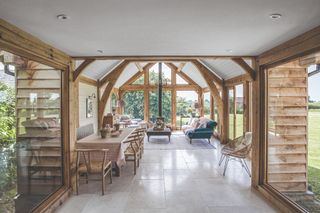I'm a professional builder and this is how I manage a project timeline
Mark Stevenson looks at how a project timeline is managed and what tools the professionals use to make sure the build gets started, and finished, on time

As construction projects go,self buildsare among the more complex as they often incorporate an array of cutting-edge technologies that push the boundaries of what has been built before. Given the complexities, it's no wonder that time often slips as the build sequence becomes complicated and challenged by competing pressures and unexpected problems.
For experienced construction professionals, managing time is an everyday feature as they juggle priorities and plan ahead to keep the build on track. Not surprisingly, some builders do this quite well while for others time management appears chaotic as they continuously react to unexpected circumstances.
The key to successful time management is effective planning and prioritisation. On construction projects, time management also requires a sound knowledge of what is being built and how best to build it along with excellent communication skills to make sure everyone plays their part in getting the job done.
The critical path
Depending upon the scale of the project, the specification required and how well organised you are, as a good rule of thumb, a typical self-build project is going to take around6 monthsto build on site.
In managing the timeline, professionals focus on what’s known as the ‘critical path’. The critical path is made up of the tasks that can only be completed in sequence, the total duration of which will define how long the project will take to build. The critical path excludes any stages that can be undertaken simultaneously. For example, the external landscaping can be completed at the same time as the internal fit out and therefore isn’t counted in the critical path duration.
When considering the critical path, brick and block will take longer to build than timber frame or Structural Insulated Panels (SIPs) as the superstructure has to be built on site, brick by brick and must be fully completed before any internal works can commence. In comparison, timber frames and SIP’s are built off-site and rapidly erected on site to enable the internal trades to progress at the same time as the enveloping trades. This effectively shaves about a month off the build schedule.
Weather will also influence how long a project will take to build and of the three methods here, brick and block is most susceptible to weather related delays — bricks and blocks can't be laid on rainy or and very cold days. A bit of an urban myth is that SIP’s are the fastest of the three construction methods. Whilst SIP’s are a quick build system, timber frame is just as quick as both are manufactured off-site and delivered to site in a very similar panellised form.

Steps to take when managing a project timeline
1. The pre-start checklist
The pre-start phase is where the planning and preparation activities take place to ensure the building phase starts properly and runs efficiently on site. It’s possibly the most important stage as it's where the DNA of a successful build is born.
The pre-start phase is made up of lots of activities, all aimed at getting ready for the build to begin. For professionals, it’s managed by following a giant ‘to do list’ of all the important tasks that must be completed before starting work.
Each project will have its on unique set of circumstances and therefore, to some degree, the ‘to do’ list will need to be crafted around the specifics involved. When putting together the pre-start checklist, it’s important to employ logic to make sure your decisions and actions are taken in the right order to avoid problems further down the line. For example, as the architectural design will need to be based upon a build system, its best to choose what you are going to build with before your architect completes the building design.
2. Creating a build programme
The build programme is a detailed timeline that outlines the sequences of activities, how long they should take and when they must be done to ensure the project is finished on time.
Build programmes should be specific to your project and reflect the specification involved as well as the time of year the build will take place. For example, if you are going to build through winter with brick and block, factor in additional time to account for weather related delays.
If you plan to use a project manager orturnkey builderto deliver your project, they will be responsible for managing time and should put together an appropriate build programme. If you intend to go down theself build DIY route,you’ll need to roll up your sleeves and do a bit of digging to figure out the details and identify the best sequence of getting things done – remembering the critical path of course!
Professionals tend to use planning software such as Microsoft’s Project to put together build programmes. While planning software is great and includes tools to manage the critical path and resources on site, they are best suited for larger scale commercial projects where there’s a greater level of complexity to manage. While there is a degree of complexity to self build projects, in my view it’s not of a level where professional planning software is needed. My advice is to make use of easily accessible software such as spreadsheets to set out the build plan in a format that can be easily communicated and understood.
记住,管理项目时间要求ore than just a plan — they must be realistic and require commitment from all involved to work as a team. Don’t forget, plans are ‘out of date’ the minute they’re issued so as the build progresses, keep a close eye on progress and if necessary, change your plan to account for problems and unforeseen issues.

3. Remember to write a short term programme
No matter how much we think it won't happen, events will take place that will knock a build off track and therefore it's inevitable that at some stage the build programme will slip. When this happens, it’s useful to focus in on the detail to make sure the necessary tasks are completed to pull the build back on track. This is best done with what’s known as a short term programme.
A short term programme is a detailed plan that focuses on either a specific stage or the month ahead. It outlines the specific sequence of activities that need to be completed over a shorter duration usually ranging from a few weeks to a month. As the short term programme only focuses on shorter periods, it brings clarity to the next steps and is therefore a useful tool for both professionals and self builders to steer a project and manage conflicting priorities.

The build-schedule checklist
This build-schedule checklist will help you keep yourself build scheduleon track:
- Put together programmes that reflect the specifics of your project.
- Consult suppliers and subcontractors to agree build periods and sequence and secure their commitment to delivery.
- Communicate your expectations — set easily understandable deadlines and objectives but make sure they are realistic.
- Think in stages – plan to complete work as you go – avoid loose ends!
- Review progress regularly and adjust your plan to suit new circumstances. Use a short term programme to pull things back on track.

Planning to self-build your own home? Our guide toSelf-Build Project Managementis filled with useful information about choosing the best route for your project. Plus, our gallery features '10 Contemporary Self-build Homes' and 'Stunning Scottish Self-Builds' are both full of inspiring ideas to get your imagination soaring.
Get the Homebuilding & Renovating Newsletter
Bring your dream home to life with expert advice, how-to guides and design inspiration, direct to your inbox.
Mark Stevenson has worked as a construction professional for almost 30 years and following an extensive career in housebuilding became Managing Director of Potton where he now helps self builders build their own homes.
Whilst Mark describes himself as a ‘professional builder’ as a result of his career in housebuilding and timber systems manufacturing, he has specialist knowledge of timber construction and extensive expertise in finding land and appraising building plots.
He regularly shares his knowledge at Homebuilding & Renovating Shows and in Potton’s Self Build Academy where he leads the finding land and how to build seminar programme.
Aside from Mark’s professional career, his skills also extend to practical building knowledge as a skilled joiner, hands-on renovator and serial self-builder of his own development projects.
He is also Vice Chair of industry body, theStructural Timber Association.
Most Popular

BySam Webb
